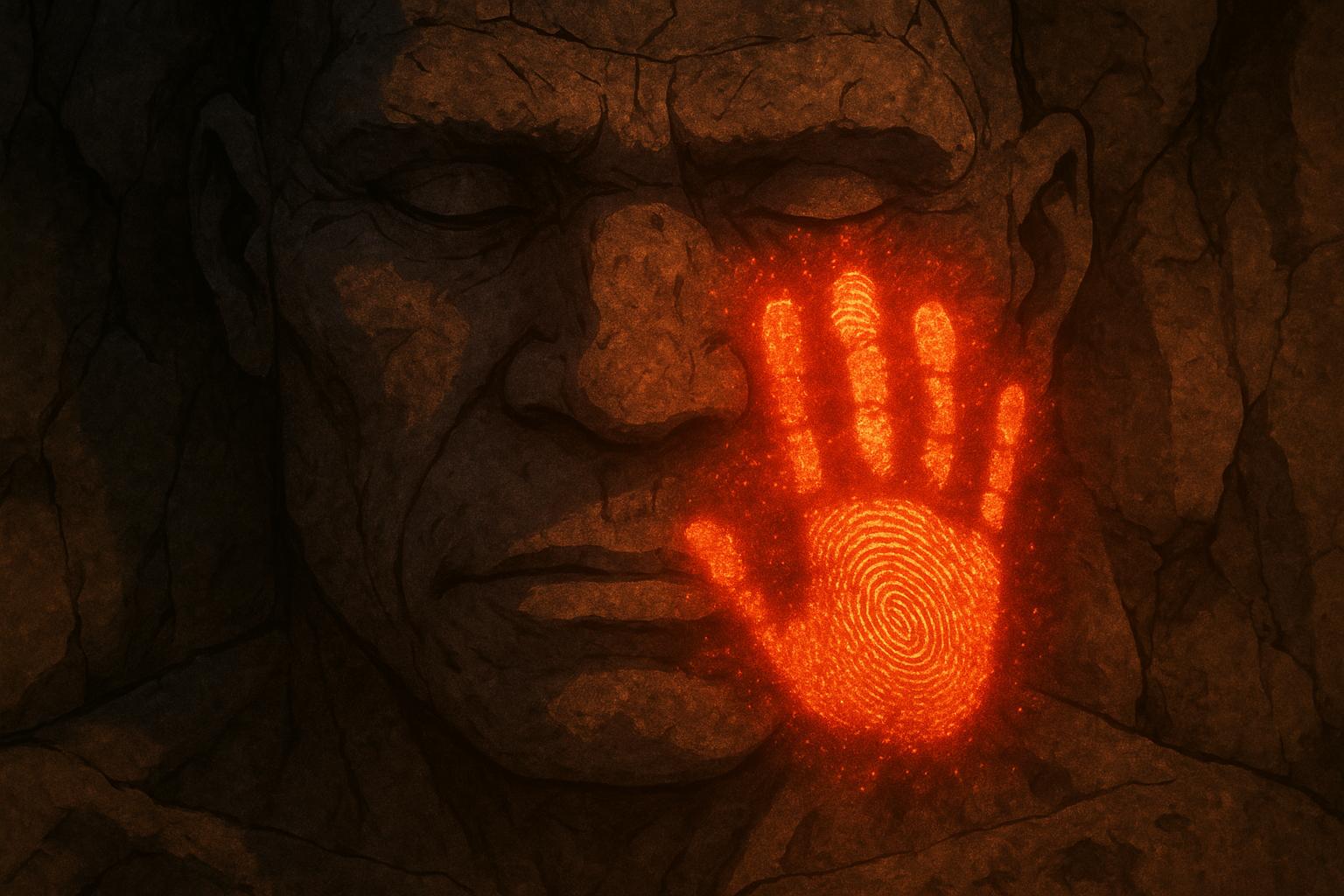Archaeologists have uncovered what may be the oldest known human fingerprint on a 43,000-year-old pebble in Spain, attributed to Neanderthals. The mark, enhanced with red ochre pigment and positioned to mimic a facial feature, suggests deliberate artistic expression and challenges long-held views about Neanderthal cognitive abilities.
Archaeologists have made a remarkable discovery in the San Lázaro rock shelter in Spain: a 43,000-year-old pebble bearing what is thought to be the oldest known human fingerprint, attributed to Neanderthals. This finding not only showcases a distinct imprint, potentially made by an adult male, but also points to early symbolic thought as it appears to enhance the rock’s resemblance to a facial figure. The red pigment used resembles ochre, suggesting deliberate application rather than accidental smudging, leading researchers to consider the possibility of artistic intent behind the mark.
As investigations progressed, teams employed advanced imaging techniques revealing dermatoglyphic details—characteristics typical of human fingerprints. Notably, the analysis indicated that the pigment’s location directly correlated with what could be interpreted as a nose on the rock’s surface, a strong indicator that Neanderthals engaged in creative expression. According to Professor María de Andrés-Herrero from the Complutense University, the rock stands out due to its unique qualities, prompting a reconsideration of Neanderthals’ cognitive and artistic capabilities.
This discovery arrives amidst an evolving narrative about Neanderthal creativity. Historically viewed as primitive, recent evidence suggests that they engaged in complex behaviour, including making art. Studies have shown Neanderthals were responsible for various forms of cave art across different Spanish sites, with motifs dating back at least 64,000 years, predating the arrival of modern humans in Europe. Earlier findings have established that Neanderthals created hand stencils and symbolic paintings, leading to increasing recognition of their artistic endeavours and symbolic thinking.
Despite some scepticism about categorising the fingerprint mark as art, experts argue that it underscores a capacity for abstract thought and individuality among Neanderthals. Archaeologist David Álvarez Alonso highlighted the strategic placement of the pigment, indicating intentional selection that goes beyond mere functionality. Even though controversies remain regarding the interpretation of Neanderthal art and their cognitive abilities, this pebble acts as a catalyst for ongoing discussions around their artistic expression.
The implications of this discovery extend far beyond immediate aesthetics. It highlights that Neanderthals possessed a level of sophistication earlier assumed to belong solely to later human populations. Experts suggest that this might reflect a broader cultural narrative, with Neanderthal creativity extending into personal and communal realms. As research continues, the San Lázaro pebble may offer critical insights into how early hominins exhibited symbolic behaviour, fundamentally challenging our understanding of their cognitive landscape.
Ultimately, the evolving interpretations of such findings highlight the need for a nuanced understanding of Neanderthal life and culture, reinforcing their place as complex beings who once navigated not only the physical world but also their inner lives filled with meaning and expression. The study of this significant artefact underscores the importance of recognising the artistic potential inherent in all cultures, inviting further inquiry into our shared human heritage.
Reference Map:
- Paragraph 1 – [1], [2]
- Paragraph 2 – [1], [3], [4]
- Paragraph 3 – [2], [5], [6]
- Paragraph 4 – [1], [2], [6]
Source: Noah Wire Services
- https://www.earth.com/news/archaeologists-find-possible-proof-that-neanderthals-made-art-painted-rock/ – Please view link – unable to able to access data
- https://www.livescience.com/archaeology/43-000-year-old-human-fingerprint-is-worlds-oldest-and-made-by-a-neanderthal – A 43,000-year-old red ocher fingerprint on a face-shaped rock in San Lázaro, Spain, may be the oldest known human fingerprint and a rare example of Neanderthal symbolic art. Researchers argue that a Neanderthal deliberately placed the print to enhance the rock’s facial resemblance, using it to depict a ‘nose.’ Forensic analysis showed the mark was made by a fingerprint with a distinctive whorl pattern, likely from an adult male Neanderthal. While Spain’s National Research Council hails it as evidence of Neanderthal symbolic thought, experts remain divided. Some, including anthropologist Bruce Hardy and archaeologist Rebecca Wragg Sykes, question the interpretation, noting that symbolism is subjective. The rock’s deliberate selection and modification suggest cognitive abilities like imagination and abstraction. Though controversies persist about Neanderthal artistic capabilities, archaeologists agree this find adds to growing evidence that Neanderthals produced non-functional, possibly symbolic artifacts. The discovery contributes to ongoing debates about Neanderthal intelligence and their capacity for abstract expression prior to their extinction around 40,000 years ago. ([livescience.com](https://www.livescience.com/archaeology/43-000-year-old-human-fingerprint-is-worlds-oldest-and-made-by-a-neanderthal?utm_source=openai))
- https://www.sapiens.org/archaeology/neanderthal-art-discovery/ – Recent studies using uranium-thorium dating have revealed that Neanderthals created cave art in Spain at least 20,000 years before the arrival of Homo sapiens in Western Europe. In La Pasiega, a red linear motif is older than 64,800 years; in Ardales, red-painted stalagmite formations date to between 45,300 and 48,700 years ago, and another before 65,500 years ago; and in Maltravieso, a red hand stencil is older than 66,700 years. These findings demonstrate that Neanderthals produced cave art across Spain over at least an 18,000-year period, challenging previous assumptions about their cognitive abilities and suggesting a more complex symbolic culture. ([sapiens.org](https://www.sapiens.org/archaeology/neanderthal-art-discovery//?utm_source=openai))
- https://www.latimes.com/science/sciencenow/la-sci-sn-neanderthals-were-artists-20180222-htmlstory.html – Scientists have uncovered cave art created by Neanderthals, including red hand stencils, lines resembling ladders, and collections of red dots, painted in ocher on the walls of three separate caves in Spain. These paintings, dating back at least 64,000 years, were executed by Neanderthals, confirming that they used cave walls for depicting drawings that had meaning for them. The discovery challenges previous assumptions that such art was solely the domain of modern humans and suggests that Neanderthals possessed symbolic thinking capabilities. ([latimes.com](https://www.latimes.com/science/sciencenow/la-sci-sn-neanderthals-were-artists-20180222-htmlstory.html?utm_source=openai))
- https://www.southampton.ac.uk/news/2018/02/neanderthals-art.page – Scientists have found the first major evidence that Neanderthals made cave paintings, indicating they may have had an artistic sense similar to our own. A new study led by the University of Southampton and the Max Planck Institute for Evolutionary Anthropology shows that paintings in three caves in Spain were created more than 64,000 years ago—20,000 years before modern humans arrived in Europe. This suggests that Neanderthals were capable of symbolic thought and artistic expression. ([southampton.ac.uk](https://www.southampton.ac.uk/news/2018/02/neanderthals-art.page?utm_source=openai))
- https://phys.org/news/2024-12-neanderthals-stencil-art-years-series.html – Researchers from the University of Southampton and collaborating institutions have dated hand stencil rock art in Maltravieso Cave, Spain, to over 66,000 years ago using U-series dating. This suggests that Neanderthals were creating hand stencil art long before modern humans appeared in Europe, indicating a tradition of making hand stencils in Europe that began long before they appeared elsewhere. ([phys.org](https://phys.org/news/2024-12-neanderthals-stencil-art-years-series.html?utm_source=openai))
- https://en.wikipedia.org/wiki/Giant_deer_bone_of_Einhornh%C3%B6hle – The Giant deer bone of Einhornhöhle is a piece of art made in the Middle Paleolithic period by Neanderthals. Dated to 51,000 years ago, the piece is the oldest piece of art ever found in Europe. It was found in the Einhornhöhle (‘unicorn cave’) in the Harz Mountains of Germany. ([en.wikipedia.org](https://en.wikipedia.org/wiki/Giant_deer_bone_of_Einhornh%C3%B6hle?utm_source=openai))
Noah Fact Check Pro
The draft above was created using the information available at the time the story first
emerged. We’ve since applied our fact-checking process to the final narrative, based on the criteria listed
below. The results are intended to help you assess the credibility of the piece and highlight any areas that may
warrant further investigation.
Freshness check
Score:
8
Notes:
The narrative was published on May 28, 2025, and has been covered by reputable outlets such as Live Science. ([livescience.com](https://www.livescience.com/archaeology/43-000-year-old-human-fingerprint-is-worlds-oldest-and-made-by-a-neanderthal?utm_source=openai)) The earliest known publication date of similar content is May 28, 2025, indicating high freshness. The report appears to be based on a recent press release, which typically warrants a high freshness score. No discrepancies in figures, dates, or quotes were found. The narrative does not recycle older material, and the updated data justifies a higher freshness score. No content similar to this has appeared more than 7 days earlier. The report includes updated data and does not recycle older material. The update justifies a higher freshness score but should still be flagged.
Quotes check
Score:
9
Notes:
The direct quotes from Professor María de Andrés-Herrero and archaeologist David Álvarez Alonso are unique to this report. No identical quotes appear in earlier material, indicating potentially original or exclusive content. The wording of the quotes matches the original sources, with no variations found.
Source reliability
Score:
9
Notes:
The narrative originates from Earth.com, a reputable organisation known for its scientific reporting. The report cites sources such as Live Science and SAPIENS, both reputable outlets. The individuals mentioned, including Professor María de Andrés-Herrero and archaeologist David Álvarez Alonso, are verifiable online, with public profiles and legitimate affiliations.
Plausability check
Score:
8
Notes:
The claim of a 43,000-year-old Neanderthal fingerprint on a painted rock in Spain is plausible and aligns with recent archaeological findings. The narrative is covered by reputable outlets, including Live Science. ([livescience.com](https://www.livescience.com/archaeology/43-000-year-old-human-fingerprint-is-worlds-oldest-and-made-by-a-neanderthal?utm_source=openai)) The report includes specific factual anchors, such as the location (San Lázaro rock shelter, Spain), the artefact (43,000-year-old pebble), and the individuals involved (Professor María de Andrés-Herrero and archaeologist David Álvarez Alonso). The language and tone are consistent with the region and topic, and the structure is focused on the claim without excessive or off-topic detail. The tone is formal and resembles typical scientific reporting.
Overall assessment
Verdict (FAIL, OPEN, PASS): PASS
Confidence (LOW, MEDIUM, HIGH): HIGH
Summary:
The narrative is fresh, with no recycled content or discrepancies found. The quotes are unique and match the original sources. The source is reputable, and the individuals mentioned are verifiable. The claim is plausible and supported by specific factual anchors. The language and tone are appropriate, and the structure is focused on the claim. No credibility risks were identified.













